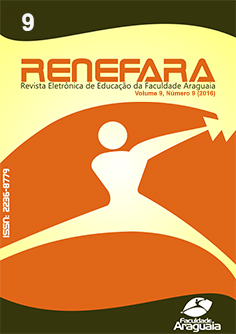ARQUITETURA FOLIAR DE ESPÉCIES ARBÓREAS DO BOSQUE AUGUSTE DE SAINT-HILAIRE, GOIÂNIA, GOIÁS, BRASIL
Keywords:
diafanização, broquidódromo, aréolas, vênulasAbstract
Para a conservação das espécies, a precisão no processo de identificação é altamente relevante para saber se está sendo explorada uma espécie rara ou em via de extinção ou até mesmo se ainda não é conhecida pela ciência. A grande variedade de espécies vegetais, com suas inúmeras características taxonômicas, torna a problemática da identificação morfológica um dos principais desafios para a conservação das mesmas. Para minimizar as dificuldades na identificação de espécies arbóreas, a utilização de novas ferramentas pode minimizar a complexa tarefa de identificação, desses problemas. O estudo da arquitetura foliar pode contribuir muito para o estudo da biodiversidade e conservação de espécies vegetais. Foram estudadas as lâminas foliares de 10 espécies arbóreas distribuídas em seis famílias distintas, ocorrentes no Bosque Auguste de Saint-Hilaire, Goiás, com o objetivo caracterizar seus padrões de venação e identificar caracteres úteis para a taxonomia dos grupos. A técnica de diafanização utilizada seguiu metodologia de Shoder e Lester (com algumas modificações. O padrão de venação de segunda, terceira, quarta e quinta ordens foram descritos e ilustrados para as 10 espécies, detalhando-se a ilustração das aréolas. Sendo o padrão broquidódroma constante entre as espécies estudas. Foram avaliados aspectos relativos ao tipo e número de lados das aréolas e a presença ou não de vênulas. A arquitetura foliar como ferramenta taxonômica mostrou-se capaz de fornecer características diagnósticas entre as espécies coletadas, principalmente entre as vênulas.
Downloads
Published
Issue
Section
License
The copyright of the published articles will be transferred to the Uniaaraguaia Magazine, allowing its subsequent reproduction as transcription and with due citation of source. In the event of acceptance and before the publication of the article, the plaintiff (s) shall write a statement formally transferring copyright to the magazine.
The author may also print and distribute copies of his article, provided that he mentions that the rights belong to the Uniaaraguaia Magazine.
Author rights include the right to reproduce in full or partly by any means, distribute this article, including figures and photographs.
By submitting originals to the Uniaaraguaia magazine, the author or authors express agreement with the following terms:
a) Authors maintain copyright and grant Uniaraguaia magazine the right of first publication, with the work simultaneously licensed under the Creative Commons Attribution license that allows the sharing of work with recognition of the authorship and initial publication in this magazine.
b) Authors are authorized to assume additional contracts separately, for non-expiration distribution of the work version published in this magazine (eg publish in institutional repository or as book chapter), with recognition of authorship and initial publication in this journal.
c) Authors are allowed and are encouraged to publish and distribute their work online (eg in institutional repositories or on their personal page) to any point before or during the editorial process, as this can generate productive changes as well as increase the impact and citation of published work.

